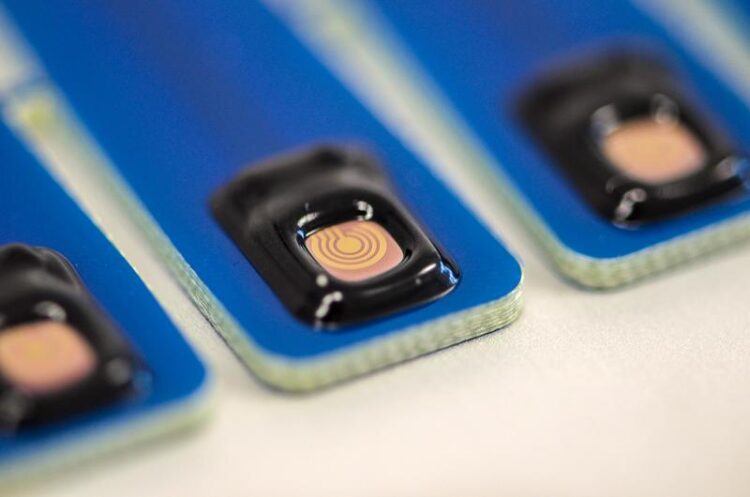New multi-sensor system for water analysis

Conductivity sensor, with and without temperature sensor Pt1000 available
© Fraunhofer IPMS / Franka Balvin
With groundbreaking developments in the field of chemical sensor technology, the Fraunhofer Institute for Photonic Microsystems IPMS is setting new standards in the assessment of water quality for humans and the environment. In addition to key parameters such as conductivity and pH, nutrients such as nitrate, phosphate and potassium will also play an important role as key ions in the future. Their evaluation is particularly important in environmental analysis, agriculture and water management.
In the Chemical Sensors and Systems business unit, the Fraunhofer IPMS research team has been working intensively on the development of state-of-the-art ion-sensitive field-effect transistors (ISFET) and capacitive conductivity sensors that can be seamlessly integrated into environmental measurement systems. Innovative control electronics have now been developed for the successful and efficient use of the sensors, enabling extremely flexible and energy-efficient use of these sensors.
Demonstrator for pH and conductivity measurement. ©Fraunhofer IPMS / Franka Balvin
The outstanding properties of the pH sensors from Fraunhofer IPMS are particularly noteworthy, as Dr. Olaf Hild, Head of the Chemical Sensor Technology Business Unit at the institute, reports: “The low drift of less than 20 µV/h, the wide addressable pH range from pH 1 to pH 13 as well as the extremely small hysteresis and low light sensitivity make our pH sensors unique. Added to this is their impressive mechanical stability.” In addition, the conductivity sensors with a measuring range from 10 µS/cm to 100 mS/cm offer versatile application possibilities for environmental analysis. The sensors can also be adapted to customer-specific requirements, both sensory and electrical.
These pioneering technologies from Fraunhofer IPMS help to significantly increase the efficiency and precision of environmental analysis and open up new possibilities for individual applications in various industries.
The developed electronics, together with the ISFETs and the conductivity sensors, will be presented at the “analytica” trade fair from April 9 to 12 in Munich. Interested users will have the opportunity to examine the performance and discuss specific requirements for their individual purposes at the Fraunhofer IPMS stand A3.407. Appointments for expert discussions with scientists and developers can be arranged in advance via the Fraunhofer IPMS website.
Physical principles of the ISFET from Fraunhofer IPMS
The capacitive conductivity sensor developed by Fraunhofer IPMS uses a metallic 4-electrode arrangement coated with a chemically and mechanically robust metal oxide. This design ensures that the measuring medium only contacts the oxide and not the electrode metal, preventing the release or contamination of metal ions during measurement. The sensors have a cell constant of 0.8 to 1.1 cm-1 and can be used at a measuring frequency in the range of 100 Hz to 1 MHz.
The novel ISFET from Fraunhofer IPMS is based on metal-oxide-semiconductor (MOS) field-effect transistor technology, whereby the sensor area in contact with the medium consists of an amphoteric metal oxide layer. This pH-sensitive layer reversibly adsorbs hydronium or hydroxide ions from the measuring medium based on the pH value. The voltage (VGS) measured between the source electrode and the gate or reference electrode (Ag/AgCl in 3M KCl) is then used as the measurement signal.
Some of the research results were achieved in the “REISen” project, a project in the field of materials science, which was co-financed from tax funds on the basis of the budget approved by the Saxon State Parliament.
About Fraunhofer IPMS
Fraunhofer IPMS is one of the leading international research and development service providers for electronic and photonic microsystems in the application fields of intelligent industrial solutions and manufacturing, medical technology and health, and mobility. In two state-of-the-art clean rooms and with a total of four development sites in Dresden, Cottbus and Erfurt, the institute develops innovative MEMS components and microelectronic devices on 200 mm and 300 mm wafers. Services range from consulting and process development to pilot production.
Wissenschaftliche Ansprechpartner:
Dr. Olaf Hild olaf.hild@ipms.fraunhofer.de
Media Contact
All latest news from the category: Power and Electrical Engineering
This topic covers issues related to energy generation, conversion, transportation and consumption and how the industry is addressing the challenge of energy efficiency in general.
innovations-report provides in-depth and informative reports and articles on subjects ranging from wind energy, fuel cell technology, solar energy, geothermal energy, petroleum, gas, nuclear engineering, alternative energy and energy efficiency to fusion, hydrogen and superconductor technologies.
Newest articles

Innovative 3D printed scaffolds offer new hope for bone healing
Researchers at the Institute for Bioengineering of Catalonia have developed novel 3D printed PLA-CaP scaffolds that promote blood vessel formation, ensuring better healing and regeneration of bone tissue. Bone is…

The surprising role of gut infection in Alzheimer’s disease
ASU- and Banner Alzheimer’s Institute-led study implicates link between a common virus and the disease, which travels from the gut to the brain and may be a target for antiviral…

Molecular gardening: New enzymes discovered for protein modification pruning
How deubiquitinases USP53 and USP54 cleave long polyubiquitin chains and how the former is linked to liver disease in children. Deubiquitinases (DUBs) are enzymes used by cells to trim protein…



